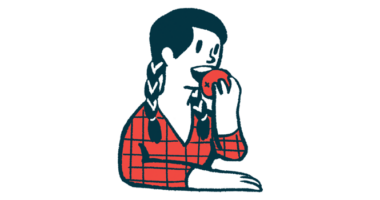Electrical Nerve Stimulation Eases Temper Outbursts in Adults with PWS, Study Suggests

Non-invasive vagus nerve stimulation (VNS) — which sends signals to a key nerve that runs through the neck — may help reduce temper outbursts and improve quality of life in adults with Prader-Willi syndrome (PWS), a small trial suggests.
The study, “Transcutaneous vagus nerve stimulation (t-VNS): A novel effective treatment for temper outbursts in adults with Prader-Willi Syndrome indicated by results from a non-blind study,” was published in the journal PLOS ONE.
Severe temper outbursts are commonly seen in children with PWS and continue into adulthood, affecting the quality of life of both patients and caregivers. However, what underlies this type of behavior remains unclear.
VNS involves delivering electrical impulses to the vagus nerve, a key nerve that runs through the neck and innervates organs such as the pharynx, larynx, heart, and bowel. This type of treatment has been used mainly to treat epilepsy, with patients showing behavioral and cognitive improvements.
In a previous small study, researchers from the University of Cambridge found that VNS may safely reduce problematic behaviors and improve social skills in adults with PWS.
Now, the same team of scientists sought to assess the effectiveness of transcutaneous, or through the skin, VNS — known as t-VNS — as a therapy for temper outbursts in PWS patients. An electrical stimulator was connected to an earpiece that provided the stimulation to the left ear.
This technique has been associated with increased brain levels of Gamma-Aminobutyric acid, known as GABA, a neurotransmitter or signaling molecule that suppresses the activity of nerve cells. GABA levels have been shown to be reduced in people with PWS who have temper outbursts.
The study (NCT03689621) enrolled five adults with PWS, with ages ranging from 22 to 41. The participants received daily stimulation for four hours, either in a single period or with intervals, but not during sleep. This was maintained for one year, followed by one month of daily t-VNS delivered in sessions of 2 hours.
The primary outcome was the mean number of behavioral outbursts per day, defined as those that escalate to include physical and/or verbal aggression. These behaviors were registered by carers in a diary.
Questionnaires and interviews were conducted as secondary outcome measures. These included the Challenging Behaviour Interview (CBI), which assesses the frequency, intensity, and impact of behaviors during the previous month. The higher the score on CBI, the greater the level of problems.
The researchers also assessed the impact of t-VNS on the participants’ quality of life and care demands with the goal attainment scaling light, or GAS-Light. GAS is a method of scoring the extent to which a patient’s individual goals are achieved in the course of intervention.
After nine months of stimulation, the study’s results showed that four of the five participants had a significant reduction in the number and severity of temper outbursts. The remaining participant showed no differences after stimulation.
Questionnaire and interview data supported these findings, with the CBI scores significantly reduced in the participants with eased temper outbursts. Carers reported greater regulation of emotions in patients, including an increased ability to process a situation and listen to advice.
Benefits in quality of life and care demands also were seen, the researchers said. No serious safety issues were reported.
“As a consequence of these reported improvements, participants’ abilities to manage and respond well to conditions that would have previously triggered a temper outburst improved, resulting in less frequent and lengthy temper outbursts,” the team said.
The benefits were seen only when the treatment was continued for at least four hours per day.
When the participants reduced their use of t-VNS from four to two hours per day, two of the four individuals who had shown improvements experienced a significant increase of temper outbursts. Carers of the other two patients who had shown benefits said they were more irritable and unable to be reasoned with during this phase.
In turn, the participant who failed to improve with four-hour t-VNS also experienced an increase in temper outbursts with two-hour stimulation.
After one month on daily stimulation for two hours, all participants asked to increase t-VNS back to four hours. All four who had improved chose to continue on t-VNS after the study ended and were then referred to their general practitioners for subsequent monitoring.
These results suggest that “t-VNS is an effective, novel and safe intervention for chronic temper outbursts in PWS,” the scientists said.
“All four people with PWS who improved have continued treatment and the effect on their lives has been reported as substantial,” they added.






